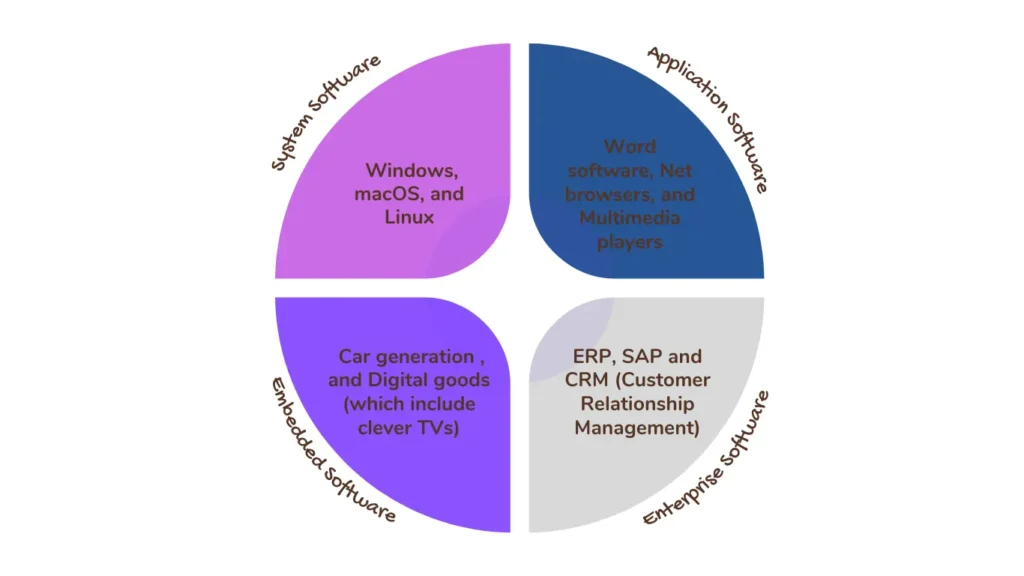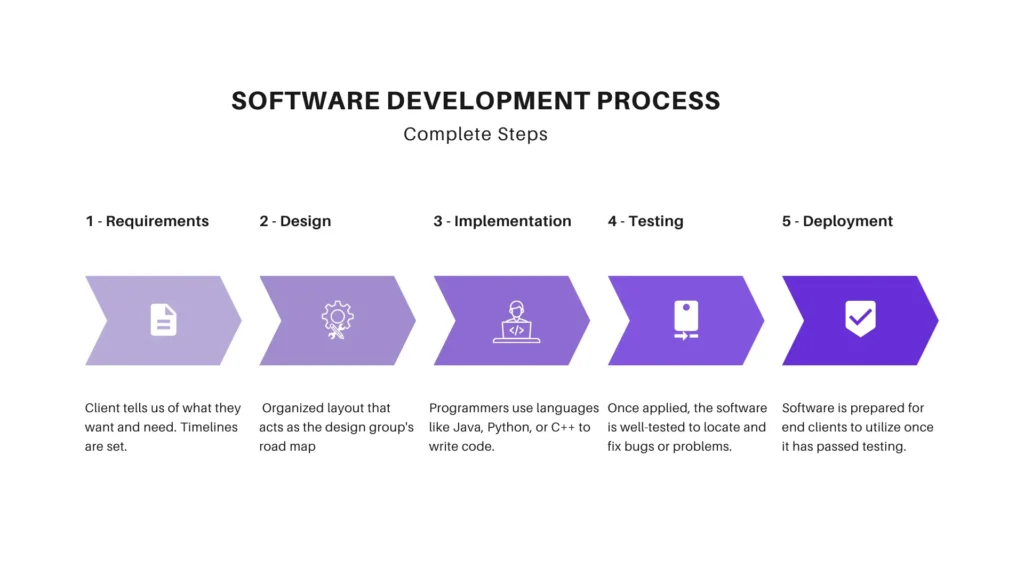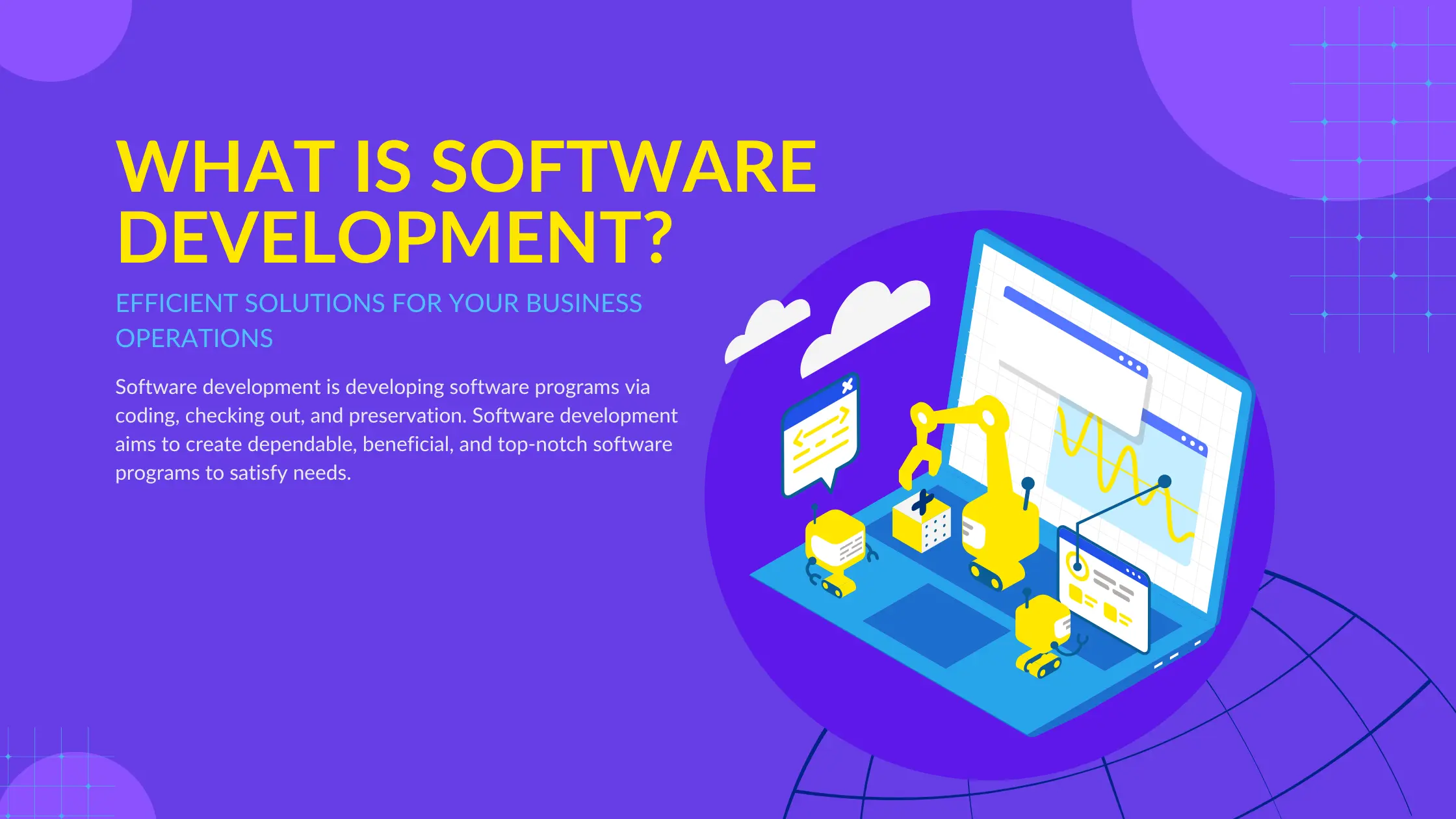Software development has emerged as virtual technology, the primary driving force behind technical growth. Software development has become established in nearly all areas of modern-day existence, from developing complex enterprise systems to growing smartphone applications. This article will examine the importance, vital components, strategies, and software program development techniques as we dig into its complexities.
What is software development and why is it important?
Software development is developing software programs via coding, checking out, and preservation. It includes various obligations, from making plans to implementation. Software development aims to create dependable, beneficial, and top-notch software programs to satisfy needs.
Why Software Development is Important?
Software development is key to promoting creativity and performance in various companies. Here are numerous explanations for its importance:
Activate Automation
Software development improves productivity and decreases errors while streamlining methods by automating repetitive work. It frees up human resources for large-scale initiatives.
Improve Communication
Software development produces applications and structures that enable smooth communication among individuals and international businesses. These assets aid in useful resources for cooperation, information exchange, and relationship development.
Enhance Decision Making
Through facts analysis, analytical software developed from software development techniques offers insightful data. It allows corporations to make properly informed selections based on precise and well-timed records.
Encourage Innovation
Software development encourages innovation by making it viable to create new goods and offerings, boosting market share, and pushing the frontiers of generation and company approaches. It is a driving force behind development and trade across diverse industries.
Types of Software Applications

Software can be divided into groups to keep with its intended use and competencies. Typical sorts include a number of the following:
System Software
It includes desktop operating systems like Windows, macOS, and Linux and drivers for gadgets. It enables conversation between the hardware elements and the running gadget. Crucial for controlling laptop hardware and serving as a platform for running software.
Application Software
Applications like word software (like Microsoft Word), net browsers (like Google Chrome), and multimedia players (like VLC Media Player) are examples of application programs. These applications are specifically designed to fulfill the needs of customers.
Application developers are responsible for planning, building, checking out, and keeping person-friendly software programs. They should be ready to troubleshoot issues for improvement at some stage. They work with numerous programming dialects and technologies.
Being an application software developer is a first-rate expert choice for individuals with the essential expertise and skills. It has a demand for capable candidates that will likely expand in the upcoming years.
Enterprise Software
Designed with large-scale enterprises in thoughts, the business enterprise software program helps the effective management of intricate techniques. Examples include ERP (Enterprise Resource Planning) programs like SAP and CRM (Customer Relationship Management) platforms like Salesforce. These examples include automated responsibilities like human resources administration, accounting, and sales.
Embedded Software
Embedded software manages specialized hardware components’ functionality by operating inside them. It is widely used in many industries, including commercial equipment (such as manufacturing robots), car generation (together with engine manipulating devices), and digital goods (which include clever TVs). Enhanced capability and ideal functioning are assured by the software program contained in those electronic gadgets.
Steps of the Software Development Process

The Software Development Life Cycle (SDLC) is a set of methods the software program development method generally adheres to. These actions consist of:
Analysis of Requirements
The first step is obtaining necessities from stakeholders and carefully examining them to comprehend consumer demands fully. This segment establishes the framework for the whole development system. It ensures that the completed result meets the desires and expectations of stakeholders and end customers.
Software Design
During this crucial phase, programmers draft a comprehensive plan describing the product’s structure, consumer experience, and performance. It entails converting acquired necessities into an organized layout that acts as the design group’s road map.
Implementation
After obtaining the layout specifications, programmers use languages like Java, Python, or C++ to write code. Using fine practices and behavior codes, the design becomes viable code at this step.
Software Testing
Once applied, the software is well-tested to locate and fix bugs or problems. Testing guarantees this system works deliberately, satisfies the standards, and provides a flawless user experience.
Software Deployment
The software is prepared for end clients to utilize once it has passed testing. This technique includes the program’s launch, installation, setup, and integration with modern environments or structures.
Software Maintenance
Maintaining the software program’s efficacy and safety after deployment requires consistent support, enhancements, and upgrades. In maintenance, problems identified by users are addressed, bugs are constant, and patches are applied. Also vital new functions or upgrades are added. It seeks to preserve the lifespan and performance of the software at some stage in its entire lifecycle.
Key Features of Successful Software Development
Successful software development largely relies upon numerous key elements, e.g.
High-Quality Products
Effective software development guarantees reliability, scalability, and maintainability, which places quality first. Ultimately, it contributes to the service or product’s fulfillment by increasing customer satisfaction. Which constructs trust via meeting or exceeding user expectations.
Collaboration
Mobility among testers, developers, and stakeholders encourages verbal exchange and know-how. It facilitates sharing ideas, opinions, and insights throughout the development method. It leads to better outcomes and extra knowledgeable alternatives.
Iterative Development
This method allows for non-stop development and adaptation to changing necessities. The development process may be broken down into smaller cycles or modifications. Which then facilitates feedback-pushed modifications and changes and leads to incremental upgrades.
Consideration of the User
Software availability, ease of use, and satisfaction are guaranteed when designed with the end customer in mind. Developers can create brilliant and compelling user experiences. It encourages acceptance and engagement through growing empathy and know-how regarding client choices and desires.
Agile Development Methodology
Through iterative development cycles, agile methodologies and Scrum encourage flexibility, deployment, and delivery of purposeful software programs. Agile teams can react to the needs of changing values. It delivers value to stakeholders quickly through flexibility, teamwork, and the adoption of client comments.
- A waterfall model is a traditional approach to growing software programs that follows a straight line of work.
- Because of its flexibility, the agile model allows fast checking out and development.
- A hybrid strategy incorporating agile and waterfall strategies is called a spiral version.
Every approach has benefits and drawbacks, and the optimal method for a specific assignment will rely on its unique necessities and goals.
Waterfall or Agile?
The project’s needs, timetable, and degree of uncertainty all impact the selection between waterfall and agile approaches. Agile accepts change and locations as a better priority in providing value to the client through incremental releases than waterfall. Which takes a linear, sequential approach where every segment should be completed earlier than happening to the following.
Differences Between Predictive and Adaptive Software Methodologies
Like waterfall development, predictive strategies are best suited for projects with properly described needs and predictable outcomes. Because they’re predicated on thorough earlier preparation and a fixed scope. Agile and other adaptive approaches, alternatively and uncertainty, promote adaptability in response to converting requirements.
- With the predictive technique, the project is deliberate and finished according to the predetermined requirements and timeline. Additionally, the waterfall approach was used to accomplish the project.
- With the adaptive approach, the task is carried out agile and iteratively without the know-how of the necessities.
Which technique, therefore, ought you to pick? The challenge you’re operating on will decide this.
- The predictive method is a possible alternative if the task is large, complex, and has clean needs.
- The adaptive approach works properly if the venture is small, agile, and has shifting demands.
Our Software Development Process
Software development process uses an agile approach custom-designed to every task’s necessities. Our procedure includes:
Organizing a Sprint
Our team cooperatively determines each sprint’s goals and priorities, ensuring they align with project management goals. We offer extra value to each generation by segmenting work into digestible quantities. We maximize productivity and adaptability to changing requirements.
Daily Stand-Ups
Our team stays in touch through quick daily meetings that enable us to discuss progress, and pinpoint issues. It successfully prioritizes assignments. It encourages openness, obligation, and interplay, which accelerates problem-fixing and choice-making.
Continuous Integration (CI) and Deployment
Our technique is based closely on automation, which makes software checking out and model deployment smooth. Automating repetitive methods, including deployment and trying out. It reduces the risk of errors and ensures fast, reliable update delivery while retaining code integrity. As a result, our development workflow is streamlined, increasing universal performance.
Jobs that Require Software Development
Skills in software program development are specifically popular in several regions, along with:
Software Developer
The responsibilities of a software program developer include developing, creating, testing, and retaining software structures. They create software program answers after analyzing consumer demands and ensuring standard requirements and specs. Programming language knowledge, problem-solving abilities, and accuracy are vital for this position to supply reliable software program solutions. Which then successfully meets customer needs and drag-and-drop software development tools.
Backend Software Developer
Developing and handling database garage and server-facet logic for online and cellular apps is an obligation of backend software developers. To ensure effective data coping and retrieval, they create APIs and beautify the performance of databases. It designs and executes server-facet architecture.
This task needs experience in database management, backend language development, and server setup to provide safe backend solutions. It easily helps in advance overall performance.
Accounting Software Development
Software developers that specialize in finance and accounting software are known as accounting software program developers. In addition to growing tools for payroll processing, invoices, and reviews on price ranges, they also design and assemble accounting structures, Which guarantee regulatory compliance.
Accounting software has expertise in programming languages, an in-depth understanding of accounting principles. The information on creating software solutions to the unique requirements of accounting companies is are prerequisite for this position.
Applications for E-Commerce Software Developer
The introduction of online buying systems and price dealing structures for e-commerce groups is the specialty of software developers for e-commerce apps. To facilitate easy online transactions, they connect payment gateways, and design and create e-commerce websites. Which incorporates purchasing cart features.
It provides safe and easy-to-use online buying experiences that promote business growth and consumer happiness. This function necessitates proficiency with net development methods, comprehension of e-commerce standards, and awareness of safety guidelines.
Conclusion
Software development is a wide discipline that calls for teamwork, creativity, and problem-solving abilities. Organizations might also successfully use software programs to generate innovation, and boost productivity. It satisfies the changing demands of customers and stakeholders by comprehending the main functions, strategies, and stages concerned.
Effective software development necessitates dedication to first-rate flexibility and ongoing development. Whether or not the use of agile techniques or extra-traditional waterfall strategies.
FAQs
What is meant by software developer?
What is the full form of SDLC?
The necessities analysis, design, implementation, testing, deployment, and upkeep levels are all included within the Software Development Life Cycle (SDLC). It provides a structure for successfully overseeing software development projects and guarantees the production of software program solutions.
Is software development the same as coding?
Writing instructions in a programming language to generate software features via layout standards is called “coding.”
What Does a Software Developer Do?
Software developers work with other specialists, such as testers and creators, to offer dependable and powerful software solutions that cater to specific needs or troubles.
What are a few software development tasks?
Writing instructions in a programming language to generate software capabilities with the aid of design requirements is called “coding.”






